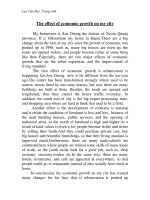effect of he environment on westward expansion
Bạn đang xem bản rút gọn của tài liệu. Xem và tải ngay bản đầy đủ của tài liệu tại đây (26.01 KB, 2 trang )
As the country grew and expanded, the American people where
always one to push their bounds. In 1763, we proudly, defied England's
proclamation of the year, and settled west of the Appalachian mountains.
A little later, the westward people pushed Indians, animals, and society to
a place where no American person had gone before. But all the while,
one important factor determined where they transported themselves,
where they settled, and what they did when they got there. This factor,
the environment, profoundly affected the settlers way of life, and other
factors, such as the Indians and the railroad, only aggravated a
pre-existing condition. The settlers of the late 1800's had only one
way to get to the west- along the pre-existing routes established by the
courier-de-bois, Spanish settlers, and the Indians of the past. These
routes, which flowed through the only passable areas of the Rockies,
naturally led to Oregon and California, which caused an increase in the
population of these regions at the time. These trails, such as the Oregon
Trail to the north, the Mormon and Spanish Trail to the south, and the
California and Overland trails in between were very rough and bumpy,
making the trek no easy task. On the home front, the environment
played an important role on the family life as well Women had a more
prominent role in society as we shifted from the urbanized east to the
more agrarian west. They were expected to do more than they did in the
past, such as make the clothing everyone in the family wore, while the
man was off toiling in the desert in search for food. With an increased
sense of independence, women had gained rights to vote and
proprietorship. But with this increased sense of independence came the
added responsibility of being the family doctor, chef, and provider of
family comfort and support. Women even faced the grim possibility of
giving birth on the trail. The environment also affected the health of
the people who lived in the west. In the middle of the desert, with scarce
sources of food and water, the people and environment became one.
With the water remote and out of hand, the emigrants faced higher
incidents of dysentery and diarrhea, which stemmed from their
inappropriate water supplies. The environment also molded another
aspect of our westward ancestors- their style of architecture and
development. In the east, where the land was expensive and hard to find,
people generally built towards the heavens. But in the lands west of the
Mississippi, where the land was found easily and very cheaply, the people
generally built outward with buildings no taller than two stories. Perhaps
we should of learned from the Indians of the past, who built in natural
recesses in the mountains to provide natural protection and shade. But
other factors also played a role in westward movement, although it's
influence wasn't as imposing as the environment. The people that already
lived in those areas, the Indians, naturally fought against these white
faced foes to keep the land that was once theirs. But other factors also
played an important role. The railroad, for instance, would ultimately
decide which areas would become populated or not as this form of
transportation became a more comfortable mode of movement. In
conclusion, one can now see the extreme influence the environment
played on the westward settlers of the past. Not only did it influence
where and how they settled, it affected their way of life, livelihood, and
general mood. While it may be said that external factors such as the
Indians and the railroad changed the direction of westward movement, it
was ultimately the environment that would decide where and how the
people settled.









